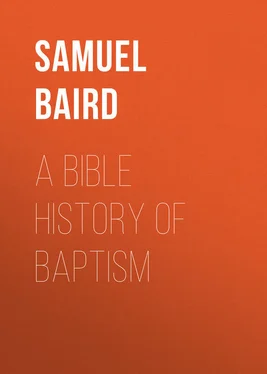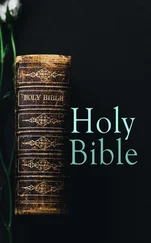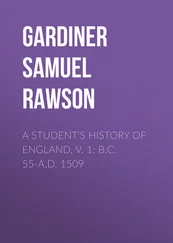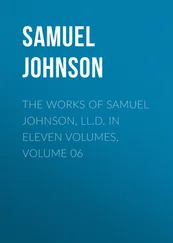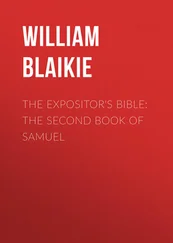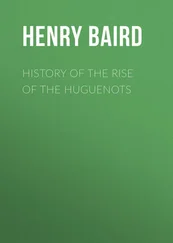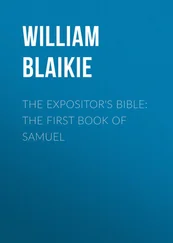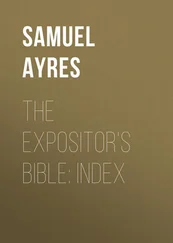Samuel Baird - A Bible History of Baptism
Здесь есть возможность читать онлайн «Samuel Baird - A Bible History of Baptism» — ознакомительный отрывок электронной книги совершенно бесплатно, а после прочтения отрывка купить полную версию. В некоторых случаях можно слушать аудио, скачать через торрент в формате fb2 и присутствует краткое содержание. Жанр: foreign_antique, foreign_prose, на английском языке. Описание произведения, (предисловие) а так же отзывы посетителей доступны на портале библиотеки ЛибКат.
- Название:A Bible History of Baptism
- Автор:
- Жанр:
- Год:неизвестен
- ISBN:нет данных
- Рейтинг книги:5 / 5. Голосов: 1
-
Избранное:Добавить в избранное
- Отзывы:
-
Ваша оценка:
- 100
- 1
- 2
- 3
- 4
- 5
A Bible History of Baptism: краткое содержание, описание и аннотация
Предлагаем к чтению аннотацию, описание, краткое содержание или предисловие (зависит от того, что написал сам автор книги «A Bible History of Baptism»). Если вы не нашли необходимую информацию о книге — напишите в комментариях, мы постараемся отыскать её.
A Bible History of Baptism — читать онлайн ознакомительный отрывок
Ниже представлен текст книги, разбитый по страницам. Система сохранения места последней прочитанной страницы, позволяет с удобством читать онлайн бесплатно книгу «A Bible History of Baptism», без необходимости каждый раз заново искать на чём Вы остановились. Поставьте закладку, и сможете в любой момент перейти на страницу, на которой закончили чтение.
Интервал:
Закладка:
It is true that, to many, the gospel then preached was of no profit, for lack of faith; whose carcasses therefore fell in the wilderness. (Heb. iii, 17-19; iv, 2.) But it is equally true that the vast majority of the assembly at Sinai were children and generous youth, who had not yet been besotted by the Egyptian bondage. To them that day, which was known in their after history as “the day of the assembly” (Deut. x, 4; xviii, 16), was the beginning of days. Its sublime scenes became in them the spring of a living faith. With honest hearts they laid hold of the covenant, and took the God of the patriarchs for their God. Soon after, the promise of Canaan, forfeited by their rebellious fathers, was transferred to them. (Num. xiv, 28-34.) Trained and disciplined by the forty years’ wandering, it was they who became, through faith, the irresistible host of God, the heroic conquerors and possessors of the land of promise. Centuries afterward, God testified of them that they pleased him: “I remember thee, the kindness of thy youth, the love of thine espousals, when thou wentest after me in the wilderness, in a land that was not sown. Israel was holiness to the Lord, and the firstfruits of his increase.” – Jer. ii, 2, 3. Until the day of Pentecost, no day so memorable, no work of grace so mighty, is recorded in the history of God’s dealings with men as that of the assembly at Sinai.
And as on the day of Pentecost the converts were baptized upon their profession of faith, so was it now. Moses appointed the next day for a solemn ratifying of the transaction. He wrote in a book the words of the Lord’s covenant, the Ten Commandments; and in the morning, at the foot of the mount, built an altar of twelve stones, according to the twelve tribes. On it young men designated by him offered burnt-offerings and sacrificed peace-offerings of young bulls. Moses took half the blood and sprinkled it on the altar. Half of it he kept in basins. He then read the covenant from the book, in the audience of all the people, who again accepted it, saying, “All that the Lord hath said will we do, and be obedient.” Moses thereupon took the blood that was in the basins, with water and scarlet wool and hyssop, and sprinkled both the book and all the people, saying, “Behold the blood of the covenant which the Lord hath made with you concerning all these words.” – Ex. xxiv, 8, compared with Heb. ix, 19, 20.
In the morning Moses had already, by divine command, assembled Aaron, Nadab and Abihu, and seventy of the elders of Israel. And no sooner was the covenant finally accepted and sealed with the baptismal rite, than these all went up into the mount, and there celebrated the feast of the covenant. “They saw the God of Israel; and there was under his feet, as it were, a paved work of a sapphire stone, and as it were the body of heaven in his clearness. And upon the nobles of Israel, he laid not his hand. Also, they saw the God of Israel, and did eat and drink.” – Ex. xxiv, 1, 9-11. So intimate, privileged, and spiritual was the relation which the covenant established between Israel and God.
Thus was closed this sublime transaction, ever memorable in the history of man and of the church of Christ, in which the invisible God condescended to clothe himself in the majesty of visible glory, to hold audible converse with men, to enter into the bonds of a public and perpetual covenant with them, and to erect them into a kingdom, on the throne of which his presence was revealed in the Shechinah of glory.
Such were the occasion and manner of the first institution and observance of the sacrament of baptism. In its attendant scenes and circumstances, the most august of all God’s displays of his majesty and grace to man; and in its occasion and nature, paramount in importance, and lying at the foundation of the entire administration of grace through Christ. It was the establishing of the visible church.
Section V. — The Blood of Sprinkling
In all the Sinai transactions, Moses stood as the pre-eminent type of the Lord Jesus Christ; and the rites administered by him were figures of the heavenly realities of Christ’s sacrifice and salvation. This is fully certified by Paul, throughout the epistle to the Hebrews, and especially in the illustration which he gives of his assertion concerning the divers baptisms imposed on Israel. See Heb. ix, 9-14, 19-28. In these places, it distinctly appears that the blood of the Sinai baptism was typical of the atonement of Christ. Not only in this, but in all the Levitical baptisms, as will hereafter appear, blood was necessary to the rite. In fact, it was an essential element in each of the Old Testament sacraments. The one idea of sacrifice was the blood of atonement. The same idea appeared in circumcision, revealing atonement by the blood of the seed of Abraham. In the passover the blood of sprinkling was the most conspicuous feature; and in the Sinai baptism blood and water were the essential elements.
Peter states the Old Testament prophets to have “inquired and searched diligently, searching what, or what manner of time the Spirit of Christ which was in them did signify, when it testified beforehand the sufferings of Christ and the glory that should follow.” – 1 Pet. i, 10, 11. Of the time and manner they were left in ignorance. But the blood, in all their sacraments, was a lucid symbol, pointing them forward to the sufferings of Christ as the essential and alone argument of the favor and grace of God. In it, and in the rites associated with it, they saw, dimly it may be, but surely, the blessed pledge that in the fullness of time “the Messenger of the covenant” would appear (Mal. iii, 2), magnify the law and make it honorable (Isa. xlii, 21), by his knowledge, justify many, bearing their iniquities (Isa. liii, 11), and sprinkle the mercy-seat in heaven, once for all, with his own precious and effectual blood – the blood of the everlasting covenant. (Heb. ix, 24-26; xiii, 20; 1 Pet. i, 11.)
Section VI. — The Living Water
In the Sinai baptism, as at first administered to all Israel, and in all its subsequent forms, living or running water was an essential element. This everywhere, in the Scriptures of the Old Testament and of the New, is the symbol of the Holy Spirit, in his office as the agent by whom the virtue of Christ’s blood is conveyed to men, and spiritual life bestowed. In the figurative language of the Scriptures, the sea, or great body of salt or dead water, represents the dead mass of fallen and depraved humanity. (Dan. vii, 2, 3; Isa. lvii, 20; Rev. xiii, 1; xvii, 15.) Hence, of the new heavens and new earth which are revealed as the inheritance of God’s people, it is said, “And there shall be no more sea.” – Rev. xxi, 1.
The particular source of this figure seems to have been that accursed sea of Sodom, which was more impressively familiar to Israel than any other body of salt water, and which has acquired in modern times the appropriate name of the Dead Sea – a name expressive of the fact that its waters destroy alike vegetation on its banks and animal life in its bosom. Its peculiar and instructive position in the figurative system of the Scriptures appears in the prophecy of Ezekiel (xlvii, 8, 9-11), where the river of living water from the temple is described as flowing eastward to the sea; and being brought forth into the sea, the salt waters are healed, so that “there shall be abundance of fish.”
Contrasted with this figure of sea water is that of living water, that is, the fresh water of rain and of fountains and streams. It is the ordinary symbol of the Holy Spirit. (John vii, 37-39.) The reason is, that, as this water is the cause of life and growth to the creation, animal and vegetable, so, the Spirit is the alone source of spiritual life and growth. The primeval type of that blessed Agent was the river that watered the Garden of Eden, and thence flowing, was parted into four streams to water the earth. This river was a fitting symbol of the Holy Spirit, “which proceedeth from the Father,” the “pure river of water of life clear as crystal, proceeding out of the throne of God and of the Lamb” (John xv, 26; Rev. xxii, 1), not only in its life-giving virtue, but in its abundance and diffusion. But the fall cut man off from its abundant and perennial stream, and thenceforth the figure, as traceable through the Scriptures, ever looks forward to that promised time when the ruin of the fall will be repaired, and the gates of Paradise thrown open again. In the last chapters of the Revelation, that day is revealed in a vision of glory. There is no more sea; but the river of life pours its exhaustless crystal waters through the restored Eden of God. But the garden is no longer the retired home of one human pair, but is built up, a great city, with walls of gems and streets of gold and gates of pearl and the light of the glory of God. And the nations of them that are saved do walk in the light of it. But still it is identified as the same of old, by the flowing river and the tree of life in the midst on its banks. (Rev. ii, 7; xxii, 1, 2; and compare Psalms xlvi, 4; xxiii, 2; John iv, 10, 14; vii, 38, 39; Zech. xiv. 8.) In Ezekiel (xlvii, 1-12) there appears a vision of this river as a prophecy of God’s grace in store for the last times for Israel and the world. In it, the attention of the prophet and of the reader is called distinctly to several points, all of which bear directly on our present inquiry:
Читать дальшеИнтервал:
Закладка:
Похожие книги на «A Bible History of Baptism»
Представляем Вашему вниманию похожие книги на «A Bible History of Baptism» списком для выбора. Мы отобрали схожую по названию и смыслу литературу в надежде предоставить читателям больше вариантов отыскать новые, интересные, ещё непрочитанные произведения.
Обсуждение, отзывы о книге «A Bible History of Baptism» и просто собственные мнения читателей. Оставьте ваши комментарии, напишите, что Вы думаете о произведении, его смысле или главных героях. Укажите что конкретно понравилось, а что нет, и почему Вы так считаете.
